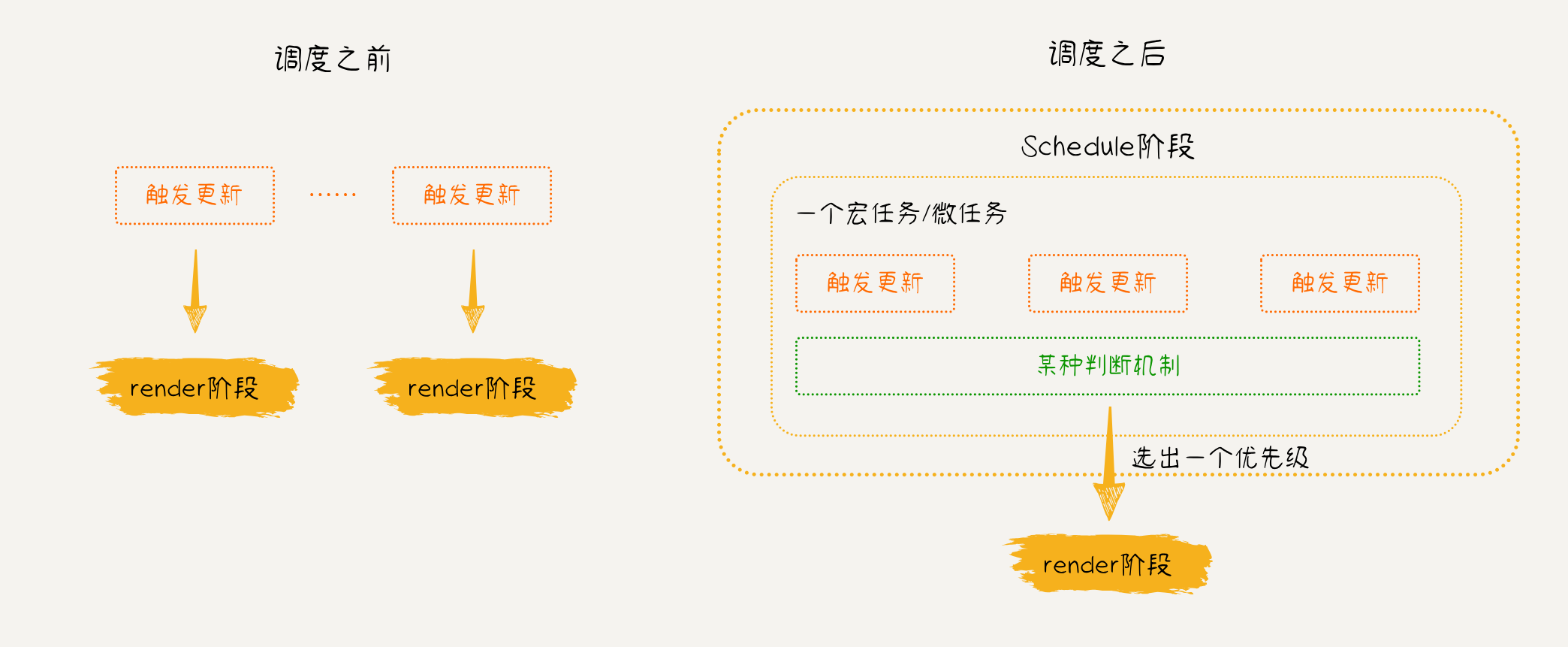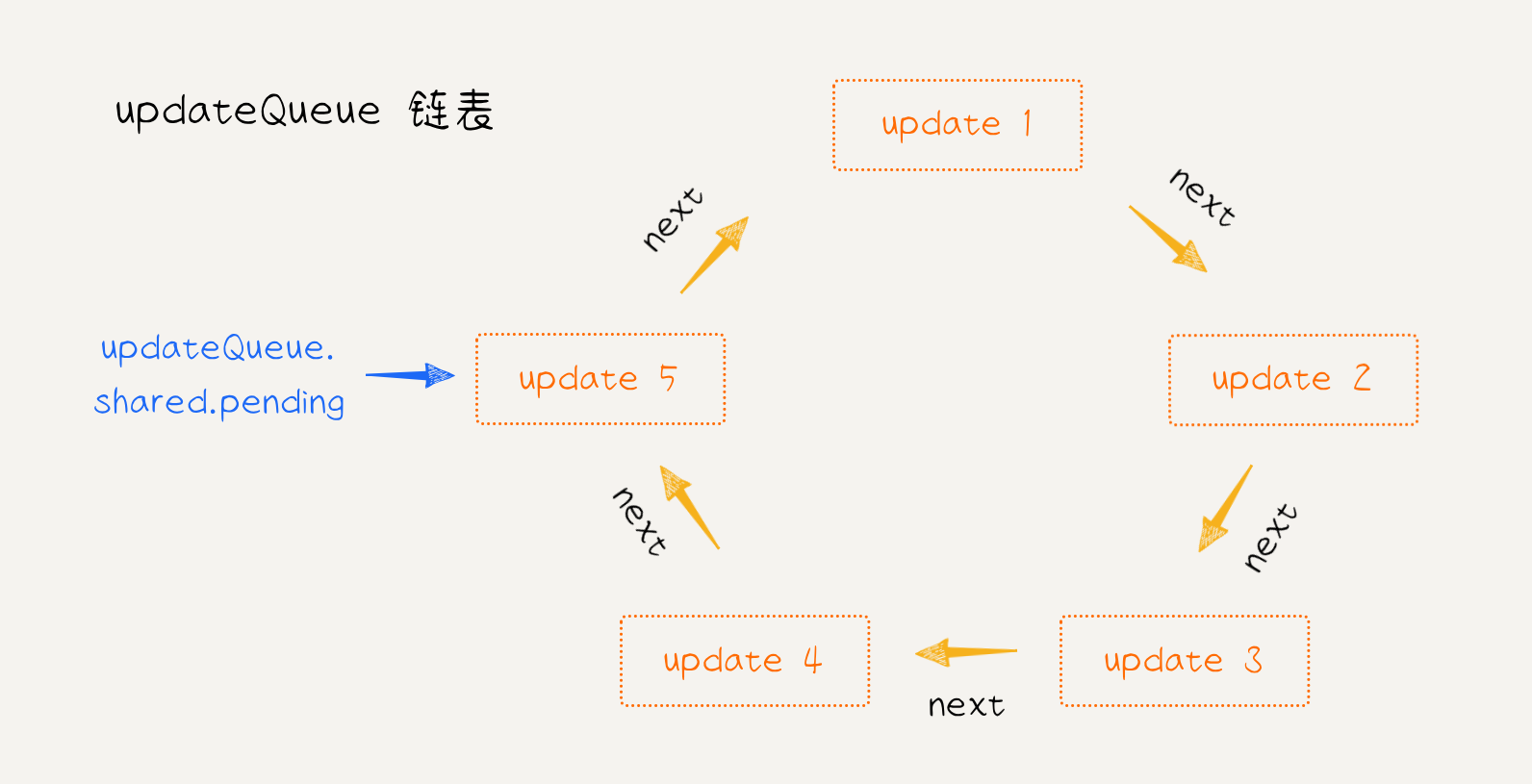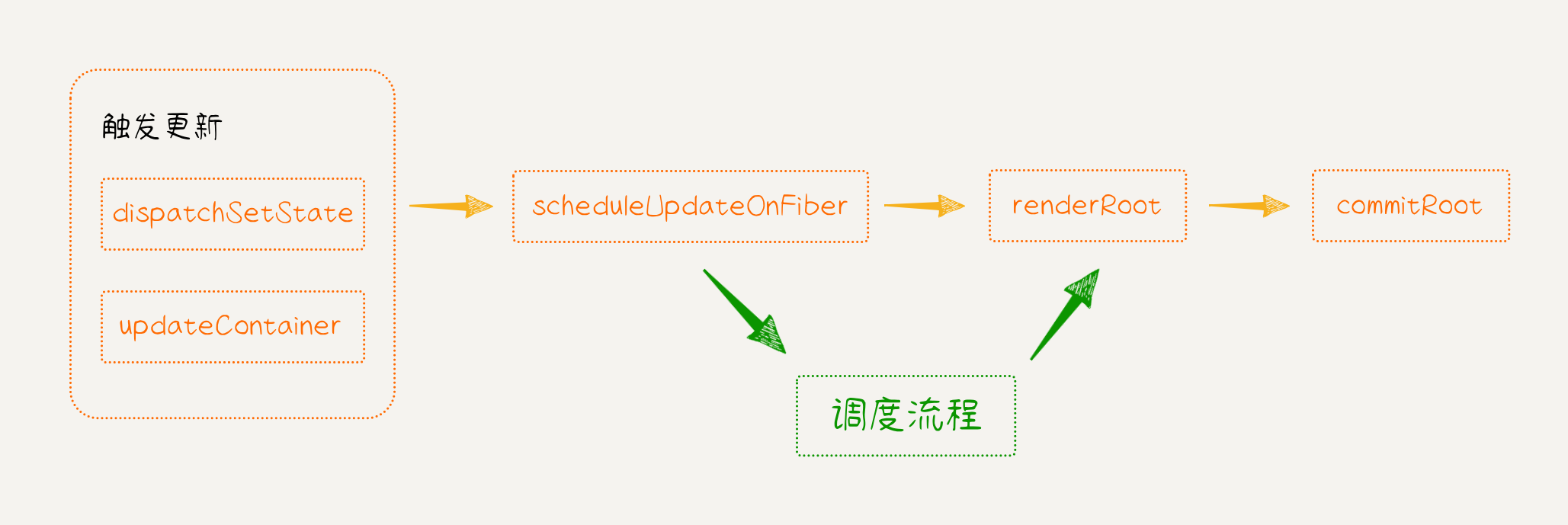14. 实现同步调度流程
14. 实现同步调度流程
目前我们实现的更新流程中,从触发更新到 Render 阶段和 Commit 阶段,都是同步的,多次触发更新会重复多次执行更新流程。

为了提升性能,React 使用了批处理(Batched Updates)机制,批处理的目标是将多个更新操作合并成一个单一的更新,从而减少不必要的计算和渲染次数,提高应用的性能和响应速度。主要包括以下几个方面:
合并更新: 当调用
setState()函数时,React 不会立即执行更新操作,而是将更新请求放入一个队列中等待执行,并将多个更新请求合并成一个更新。例如,如果一个组件在同一个事件循环中多次调用setState(),React 只会执行一次更新,并以最新的状态进行渲染异步执行: React 将更新操作延迟到浏览器的下一个事件循环中执行,以确保 UI 渲染时是最新的状态。
优先级调度: React 会根据更新的优先级和时间戳等因素进行调度,以保证在有限的时间内完成尽可能多的更新。这样可以确保及时响应用户操作,并保持良好的用户体验。
1. 实现 Lane 模型
Lane 是一个二进制的数字,表示一种优先级或者更新的类型,是用于调度和执行更新的一种机制,Lane 的数值越小,代表优先级越高;Lanes 可以看作是多个 Lane 的集合,用于表示系统中所有可能的更新任务的优先级。
通常情况下,可以将更新任务划分为不同的优先级,例如:高优先级更新、中等优先级更新和低优先级更新等。每个优先级都对应一个 Lane,当有更新任务产生时,会根据任务的优先级选择合适的 Lane,并将任务放入该 Lane 中,然后会根据 Lanes 中 Lane 的优先级顺序在合适的时机依次处理。
新建一个 fiberLanes.ts 文件,在里面实现 Lane 相关的定义和方法:
import { FiberRootNode } from './fiber';
// 代表 update 的优先级
export type Lane = number;
// 代表 lane 的集合
export type Lanes = number;
export const NoLane = 0b0000;
export const NoLanes = 0b0000;
export const SyncLane = 0b0001;
// 获取 Lane 的集合
export function mergeLanes(laneA: Lane, laneB: Lane): Lanes {
return laneA | laneB;
}
// 获取更新的优先级
export function requestUpdateLanes() {
return SyncLane;
}
// 获取 lanes 中优先级最高的 lane
export function getHighestPriorityLane(lanes: Lanes): Lane {
// 默认规则:数值越小,优先级越高
return lanes & -lanes;
}
// 从根节点的 pendingLanes 中移除某个 lane
export function markRootFinished(root: FiberRootNode, lane: Lane): void {
root.pendingLanes &= ~lane;
}
2. 改造更新链表
每个 Fiber 节点的更新都保存在 updateQueue 属性中,当有新的更新时,会调用 enqueueUpdate 函数将 update 添加到 updateQueue 中。
但是目前我们实现的 enqueueUpdate 函数是直接将 update 赋值给 updateQueue,这样会覆盖掉之前的 update。
因此我们需要对 enqueueUpdate 函数进行修改,以确保新的更新能够正确地添加到更新队列中,可以采用一种链表的方式来组织更新队列,每个更新对象都保存着下一个更新对象的引用,从而形成一个链表结构,确保更新操作能够按顺序执行:

// packages/react-reconciler/src/updateQueue.ts
// 将 Update 添加到 UpdateQueue 中的方法
export const enqueueUpdate = <State>(
updateQueue: UpdateQueue<State>,
update: Update<State>
) => {
const pending = updateQueue.shared.pending;
if (pending === null) {
update.next = update;
} else {
update.next = pending.next;
pending.next = update;
}
// pending 指向 update 环状链表的最后一个节点
updateQueue.shared.pending = update;
};
在这段代码中,我们将新的 update 添加到了更新链表的末尾,并将 update.next 指针指向链表中的第一个更新对象,最后将 updateQueue.shared.pending 指向 update,也就是链表的最后一个更新,这样可以方便我们添加和获取更新。
接着,我们为 Update 数据结构增加 next 和 lane 两个字段,同时修改创建 Update 实例的方法:
// packages/react-reconciler/src/updateQueue.ts
import { Lane } from './fiberLanes';
// 定义 Update 数据结构
export interface Update<State> {
action: Action<State>;
next: Update<any> | null;
lane: Lane;
}
// 创建 Update 实例的方法
export const createUpdate = <State>(
action: Action<State>,
lane: Lane
): Update<State> => {
return {
action,
next: null,
lane
};
};
显然,所有调用 createUpdate 函数创建 Update 的地方,我们都需要增加 lane 参数,目前有两个方法可以触发更新: updateContainer 和 dispatchSetState,分别对应了首屏渲染阶段和组件更新阶段。
// packages/react-reconciler/src/fiberHooks.ts
import { requestUpdateLanes } from './fiberLanes';
// 用于触发状态更新的逻辑
function dispatchSetState<State>(
fiber: FiberNode,
updateQueue: UpdateQueue<State>,
action: Action<State>
) {
const lane = requestUpdateLanes();
const update = createUpdate(action, lane);
enqueueUpdate(updateQueue, update);
// 调度更新
scheduleUpdateOnFiber(fiber, lane);
}
// packages/react-reconciler/src/fiberReconciler.ts
import { requestUpdateLanes } from './fiberLanes';
export function updateContainer(
element: ReactElementType | null,
root: FiberRootNode
) {
const hostRootFiber = root.current;
const lane = requestUpdateLanes();
const update = createUpdate<ReactElementType | null>(element, lane);
enqueueUpdate(
hostRootFiber.updateQueue as UpdateQueue<ReactElementType | null>,
update
);
scheduleUpdateOnFiber(hostRootFiber, lane);
return element;
}
这两个方法调用 createUpdate 函数创建 update 之后,会将更新加入 updateQueue 链表中,然后调用 scheduleUpdateOnFiber 函数开始调度更新。
接着,我们还需要对从 updateQueue 中消费 update 的流程进行改造。
- 给
processUpdateQueue函数增加第三个参数renderLane,代表当前更新的优先级; - 由于
updateQueue是一个链表,因此需要遍历链表,依次消费符合当前更新优先级的update; - 执行完所有
update之后,将计算出的最终值赋值给result.memoizedState。
// 从 UpdateQueue 中消费 Update 的方法
export const processUpdateQueue = <State>(
baseState: State,
pendingUpdate: Update<State> | null,
renderLane: Lane
): { memoizedState: State } => {
const result: ReturnType<typeof processUpdateQueue<State>> = {
memoizedState: baseState
};
if (pendingUpdate !== null) {
// 第一个 update
let first = pendingUpdate.next;
let pending = first as Update<any>;
do {
const updateLane = pending.lane;
if (updateLane == renderLane) {
const action = pending.action;
if (action instanceof Function) {
// action 是回调函数
baseState = action(baseState);
} else {
// action 是状态值
baseState = action;
}
} else {
if (__DEV__) {
console.error('不应该进入 updateLane !== renderLane 逻辑');
}
}
pending = pending.next as Update<any>;
} while (pending !== first);
}
result.memoizedState = baseState;
return result;
};
同样,每个调用 processUpdateQueue 函数消费 Update 的地方,都需要增加一个 renderLane 参数。有两个方法可以消费更新:updateHostRoot 和 updateState,分别对应了首屏渲染阶段和组件更新阶段。
这里不一一列举改造细节了,详见 代码。
3. 实现调度阶段
在之前的更新流程中,每次触发更新后,scheduleUpdateOnFiber 函数会从当前节点向上遍历到根节点,然后调用 Render 阶段的入口 renderRoot 函数, 构建 Fiber 树、处理新旧虚拟 DOM 树之间的差异、生成更新计划;在 renderRoot 函数执行完之后又会调用 Commit 阶段的入口 commitRoot 函数,将更新同步到实际的 DOM 中。
现在为了实现批处理机制,将多个更新操作合并成一个更新,我们需要在 Render 阶段和 Commit 阶段的基础上增加 Schedule 阶段(调度阶段)。

为了方便调度优先级,我们将优先级队列保存在根节点上。根节点作为整个应用的入口,将更新的状态信息存储在根节点上统一管理,可以更快地访问和检查哪些更新需要被处理,减少在整个组件树中查找的时间。
为 FiberRootNode 数据结构增加 pendingLanes 和 finishedLane 两个字段,其中 pendingLanes 用于标识当前有哪些更新需要被处理,finishedLane 用于表示已经完成处理的更新。
// packages/react-reconciler/src/fiber.ts
import { Lane, Lanes, NoLane, NoLanes } from './fiberLanes';
export class FiberRootNode {
container: Container;
current: FiberNode;
finishedWork: FiberNode | null;
pendingLanes: Lanes;
finishedLane: Lane;
constructor(container: Container, hostRootFiber: FiberNode) {
// ...
this.pendingLanes = NoLanes;
this.finishedLane = NoLane;
}
}
接着,我们回到 scheduleUpdateOnFiber 函数,为函数增加 lane 参数。
因为所有更新的 lane 都被保存在根节点的 pendingLanes 中,所以每当触发更新时,我们都需要将此次更新的 lane 记录到 FiberRootNode.pendingLanes 中。这个工作由 markRootUpdated 函数完成:
// packages/react-reconciler/src/workLoop.ts
export function scheduleUpdateOnFiber(fiber: FiberNode, lane: Lane) {
const root = markUpdateFromFiberToRoot(fiber);
markRootUpdated(root, lane);
renderRoot(root);
}
// 将更新的优先级(lane)记录到根节点上
function markRootUpdated(root: FiberRootNode, lane: Lane) {
root.pendingLanes = mergeLanes(root.pendingLanes, lane);
}
接着就要调用 renderRoot 函数,进入 Render 阶段了。
但是我们不希望每次触发更新都执行一次更新流程,因此,要在这里插入一个调度流程,根据某种判断机制选出一个优先级,然后在一个宏任务或微任务中合并更新,只执行一次 renderRoot。

接下来,我们就来实现调度流程的入口 ensureRootIsScheduled 函数,实现原理如下:
获取最高优先级的更新:首先,从根节点的
pendingLanes中选择一个最高优先级的更新,这里使用getHighestPriorityLane函数来选择优先级最高的更新;根据优先级调度任务:根据选择的优先级,有两种不同的调度方式:
- 同步优先级(SyncLane):如果选择的优先级是同步优先级,通常意味着有一些紧急且立即需要处理的更新,那么就会使用微任务调度。在这种情况下,
renderRoot函数会被添加到微任务队列中调度执行,以确保它在当前任务执行完毕后立即执行。 - 其他优先级:如果选择的优先级不是同步优先级,说明这个更新可以稍后处理,那么就需要使用宏任务调度。在这种情况下,可以使用类似
setTimeout的机制来安排任务,在主事件循环的下一个循环周期内执行更新。
- 同步优先级(SyncLane):如果选择的优先级是同步优先级,通常意味着有一些紧急且立即需要处理的更新,那么就会使用微任务调度。在这种情况下,
安排微任务:调用
scheduleMicroTask函数安排一个微任务,在微任务中执行更新。
// packages/react-reconciler/src/workLoop.ts
import { getHighestPriorityLane } from './fiberLanes'
import { scheduleSyncCallback, flushSyncCallback } from './syncTaskQueue';
import { scheduleMicroTask } from 'hostConfig';
export function scheduleUpdateOnFiber(fiber: FiberNode, lane: Lane) {
const root = markUpdateFromFiberToRoot(fiber);
markRootUpdated(root, lane);
ensureRootIsScheduled(root);
}
// Schedule 阶段入口
function ensureRootIsScheduled(root: FiberRootNode) {
const updateLane = getHighestPriorityLane(root.pendingLanes);
if (updateLane == NoLane) return;
if (updateLane === SyncLane) {
// 同步优先级,用微任务调度
scheduleSyncCallback(renderRoot.bind(null, root, updateLane));
scheduleMicroTask(flushSyncCallback);
} else {
// 其他优先级,用宏任务调度
}
}
现在,我们来实现 scheduleSyncCallback 函数和 flushSyncCallback 函数。
新建一个 syncTaskQueue.ts 文件,这个文件中保存了与同步任务相关的状态和函数。
scheduleSyncCallbackscheduleSyncCallback函数负责将传入的回调函数callback添加到syncQueue中,syncQueue中保存了当前的同步任务队列。具体步骤如下:- 如果
syncQueue为null,表示当前没有待执行的回调函数,需要创建一个新的队列来存储回调函数; - 如果
syncQueue已经存在,则直接将回调函数添加到队列的末尾。
flushSyncCallbackflushSyncCallback函数会遍历syncQueue中的同步任务队列,并依次执行队列中的回调函数;- 我们使用
isFlushingSyncQueue标志位来表示当前是否正在执行队列中的回调函数; - 这样的设计可以确保在执行同步回调函数期间不会再次触发
flushSyncCallback函数,并且在同步执行期间防止其他异步任务的插入,以保证同步执行的正确性和稳定性; - 微任务执行完之后,重置
syncQueue和isFlushingSyncQueue。
// packages/react-reconciler/src/syncTaskQueue.ts
// 同步的任务队列
let syncQueue: ((...args: any) => void)[] | null = null;
let isFlushingSyncQueue: boolean = false;
// 调度同步的回调函数
export function scheduleSyncCallback(callback: (...args: any) => void) {
if (syncQueue === null) {
syncQueue = [callback];
}
syncQueue.push(callback);
}
// 遍历执行同步的回调函数
export function flushSyncCallback() {
if (!isFlushingSyncQueue && syncQueue) {
isFlushingSyncQueue = true;
try {
syncQueue.forEach((callback) => callback());
} catch (e) {
if (__DEV__) {
console.error('flushSyncCallback 报错', e);
}
} finally {
isFlushingSyncQueue = false;
syncQueue = null;
}
}
}
scheduleMicroTask 函数的作用是安排一个微任务,在当前任务执行完成后立即执行。
为了确保在各种不同的环境下都能够正确地安排微任务,并确保任务的及时执行,需要对不同的环境做出兼容,具体实现原理是:
- 首先,检查全局环境中是否存在
queueMicrotask函数,如果存在,则使用queueMicrotask函数来安排微任务; - 否则,检查
Promise构造函数是否存在并可用。如果可用,则创建一个Promise对象并立即将其解析(resolve),然后执行传入的回调函数。通过Promise.resolve(null).then(callback)的方式,可以将传入的回调函数作为微任务安排在微任务队列中; - 如果以上二者都没有,那么将回退到使用
setTimeout函数来安排任务。在这种情况下,会将传入的回调函数安排在下一个宏任务队列中,而不是微任务队列中。
// packages/react-dom/src/hostConfig.ts
export const scheduleMicroTask =
typeof queueMicrotask === 'function'
? queueMicrotask
: typeof Promise === 'function'
? (callback: (...args: any) => void) => Promise.resolve(null).then(callback)
: setTimeout;
现在我们已经实现了 Schedule 阶段,将多个更新合并到一个微任务中执行,现在我们来回顾一下 Schedule 阶段的流程,以下面这个函数组件为例:
function App() {
const [count, setCount] = useState(1210);
return (
<div
onClick={() => {
setCount((count) => count + 1);
setCount((count) => count + 1);
setCount((count) => count + 1);
}}
>
{count}
</div>
);
}
- 每次点击
div都会触发三次dispatchSetState更新,然后进入scheduleUpdateOnFiber函数中调度更新; - 首先,
markRootUpdated函数会将每次更新的lane存入root.pendingLanes中,经过三次mergeLanes后的root.pendingLanes值为SyncLane; - 接着,调用
ensureRootIsScheduled函数,开始调度阶段,因为此时的updateLane === SyncLane,为同步任务,因此会安排一个微任务来执行更新; scheduleSyncCallback函数会被执行三次,所以此时的syncQueue值为三个renderRoot回调函数数组([renderRoot, renderRoot, renderRoot]);flushSyncCallback函数同样会被调用三次,但是因为有isFlushingSyncQueue标志位,所以函数只会执行一次;- 最终,在
scheduleMicroTask创建的微任务中,syncQueue中的三个renderRoot回调函数会被遍历执行。
也就是说,在微任务中,renderRoot 函数还是会被执行三次,这显然不符合预期,因此,我们还需要对 renderRoot 函数及之后的更新流程做一些改造。
4. 改造更新流程
要解决上述问题,我们只需要在 renderRoot 函数第一次执行之后,也就是在进入 commitRoot 函数时,立即从根节点的 pendingLanes 中移除该更新的 lane,此时 root.pendingLanes 就为 NoLane 了。
然后在进入 renderRoot 函数时加一个判断:如果根节点的 pendingLanes 中最高优先级的 lane 不是 SyncLane,代表此时的 pendingLanes 中只剩一些比 SyncLane 低的 lane 或 NoLane 了, 直接 return 即可。
这样,我们就解决了 renderRoot 函数多次执行的问题,具体的代码实现如下:
function renderRoot(root: FiberRootNode, lane: Lane) {
const nextLane = getHighestPriorityLane(root.pendingLanes);
if (nextLane !== SyncLane) {
// 其他比 SyncLane 低的优先级或 NoLane,重新调度
ensureRootIsScheduled(root);
return;
}
// ...
}
function commitRoot(root: FiberRootNode) {
// ...
const lane = root.finishedLane;
markRootFinished(root, lane);
// 重置
root.finishedLane = NoLane;
// ...
至此,我们就实现了同步调度流程,可以将多个更新合并,按照优先级在一个微任务中执行。
同步调度流程能够即时响应状态变化和更新,一些高优先级的任务会在微任务中立即执行,从而优化了应用的性能和响应速度。通过将多个状态更新或 DOM 操作合并为一次更新执行,减少了浏览器执行的重排(reflow)和重绘(repaint)次数,这可以大大提高性能,减少页面的闪烁和卡顿。
相关代码可在 git tag v1.14 查看,地址:https://github.com/2xiao/my-react/tree/v1.14
